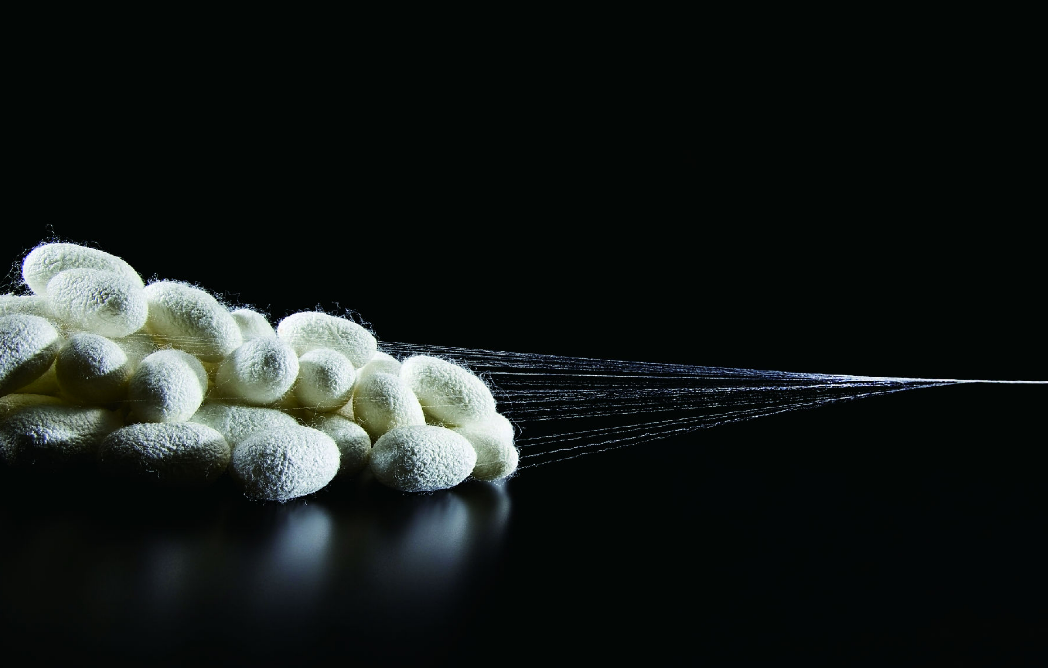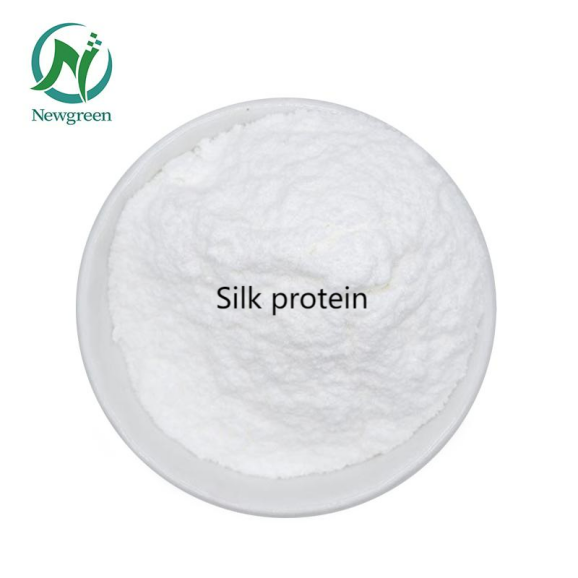
• What Is Silk Protein ?
Silk protein, also known as fibroin, is a natural high-molecular fiber protein extracted from silk. It accounts for about 70% to 80% of silk and contains 18 kinds of amino acids, of which glycine (gly), alanine (ala) and serine (ser) account for more than 80% of the total composition.
Silk protein is a versatile and valuable protein with applications in cosmetics, medicine, and textiles. Its unique properties, such as biocompatibility and moisture retention, make it beneficial for skin and hair health.
• Physical And Chemical Properties of Silk Protein
1. Physical Properties
Appearance: Silk protein is typically a soft, lustrous fiber that can be spun into threads or woven into fabrics.
Texture: It has a smooth and soft texture, making it comfortable against the skin.
Strength: Silk fibers are known for their high tensile strength, making them stronger than steel of the same diameter.
Elasticity: Silk has good elasticity, allowing it to stretch without breaking and return to its original shape.
Moisture Absorption: Silk protein can absorb moisture, helping to keep skin and hair hydrated.
2. Chemical Properties
Amino Acid Composition: Silk protein is rich in amino acids, particularly glycine, alanine, and serine, which contribute to its structural integrity and biocompatibility.
Biodegradability: Silk protein is biodegradable, making it an environmentally friendly option for various applications.
pH Sensitivity: Silk proteins can be sensitive to changes in pH, which may affect their solubility and structural properties.
Thermal Stability: Silk proteins exhibit good thermal stability, allowing them to maintain their properties under a range of temperatures.
3. Solubility
Solubility in Water: Fibroin is generally insoluble in water, while sericin is soluble, which can affect the processing and application of silk proteins.


• What Are The Benefits Of Silk Protein?
1. Skin Health
◊ Moisturizing Properties: Silk protein helps retain moisture, keeping the skin hydrated and preventing dryness.
◊ Anti-Aging Effects: It can improve skin elasticity and reduce the appearance of fine lines and wrinkles, promoting a youthful appearance.
2. Hair Care
◊ Strength and Shine: Silk protein can enhance the strength and shine of hair, making it smoother and more manageable.
◊ Damage Repair: It helps repair damaged hair by providing essential amino acids that nourish and strengthen hair strands.
3. Biocompatibility
◊ Medical Applications: Due to its biocompatibility, silk protein is used in sutures, drug delivery systems, and tissue engineering, promoting cell growth and healing.
4. Hypoallergenic Properties
◊ Gentle on Skin: Silk protein is less likely to cause allergic reactions, making it suitable for sensitive skin types.
5. Thermal Regulation
◊ Temperature Control: Silk has natural temperature-regulating properties, helping to keep the body warm in cold conditions and cool in warm conditions.
6. Environmental Benefits
◊ Biodegradability: Being a natural protein, silk is biodegradable, making it an eco-friendly choice for various applications.
• What Are The Applications Of Silk Protein ?
1. Cosmetics and Skincare
◊ Moisturizers: Used in creams and lotions for its hydrating properties.
◊ Anti-Aging Products: Incorporated into serums and treatments to improve skin elasticity and reduce wrinkles.
◊ Hair Care: Found in shampoos and conditioners to enhance shine, strength, and manageability.
2. Medical Applications
◊ Sutures: Silk protein is used in surgical sutures due to its biocompatibility and ability to promote healing.
◊ Tissue Engineering: Employed in scaffolds for tissue regeneration, as it supports cell growth and differentiation.
◊ Drug Delivery Systems: Used to create biodegradable carriers for controlled drug release.
3. Textiles
◊ Luxury Fabrics: Silk protein is a key component in high-end clothing and accessories, valued for its softness and sheen.
◊ Functional Fabrics: Used in sportswear and activewear for its moisture-wicking and temperature-regulating properties.
4. Food Industry
◊ Food Additives: Silk protein can be used as a natural emulsifier or stabilizer in certain food products.
5. Biotechnology
◊ Research Applications: Used in various biotechnological applications, including the development of biosensors and bioactive materials.
Related Questions You can Be Interested In :
♦ What are the side effects of silk protein?
Silk protein is generally considered safe for most people, especially when used in cosmetics and skincare products. However, there are some potential side effects and considerations to keep in mind:
1. Allergic Reactions
Sensitivity: Some individuals may experience allergic reactions to silk protein, particularly if they have sensitivities to proteins derived from animals. Symptoms can include itching, redness, or rash.
2. Skin Irritation
Irritation: In rare cases, silk protein may cause skin irritation, especially in individuals with sensitive skin or pre-existing skin conditions.
3. Digestive Issues
Ingestion: While silk protein is used in some food products, excessive consumption may lead to digestive discomfort in some individuals.
4. Interactions with Medications
Potential Interactions: Although not common, silk protein may interact with certain medications, particularly those that affect protein metabolism.
♦ What is the difference between keratin and silk protein?
Keratin and silk protein are both types of proteins, but they have different structures, sources, and functions. Here are the key differences:
1. Source
Keratin: A fibrous structural protein found in the hair, nails, and the outer layer of skin in animals, including humans. It is produced by keratinocytes in the epidermis.
Silk Protein: Primarily derived from the silk produced by silkworms (Bombyx mori) and some other insects. The main components are fibroin and sericin.
2. Structure
Keratin: Composed of long chains of amino acids that form a helical structure, making it tough and resilient. It can be categorized into two types: alpha-keratin (found in hair and nails) and beta-keratin (found in feathers and horns).
Silk Protein: Mainly consists of fibroin, which has a more organized, crystalline structure that contributes to its softness and sheen. It is less rigid than keratin.
3. Properties
Keratin: Known for its strength and durability, making it ideal for protective structures like hair and nails. It is less flexible than silk.
Silk Protein: Renowned for its smooth texture, moisture retention, and biocompatibility. It is softer and more elastic compared to keratin.
4. Applications
Keratin: Commonly used in hair care products (shampoos, conditioners) to strengthen and repair hair, as well as in nail treatments.
Silk Protein: Used in cosmetics, skincare, and medical applications due to its moisturizing properties and biocompatibility.
♦ Does silk protein straighten hair?
Silk protein itself does not chemically straighten hair like some treatments (e.g., keratin treatments) that alter the hair’s structure. However, it can enhance the smoothness and manageability of hair, contributing to a sleeker appearance. For actual straightening, chemical treatments or heat styling methods would be necessary.
♦ Is silk protein for hair vegan?
Silk protein is not considered vegan because it is derived from silkworms (specifically, the Bombyx mori species) and involves the harvesting of silk fibers from these insects. The process typically requires killing the silkworms to obtain the silk, which goes against vegan principles that avoid animal exploitation and harm.
Alternatives for Vegans:
If you’re looking for vegan hair care options, consider products that use plant-based proteins, such as:
Soy Protein
Wheat Protein
Rice Protein
Pea Protein
These alternatives can provide similar benefits for hair health without involving animal-derived ingredients.
Post time: Oct-09-2024






